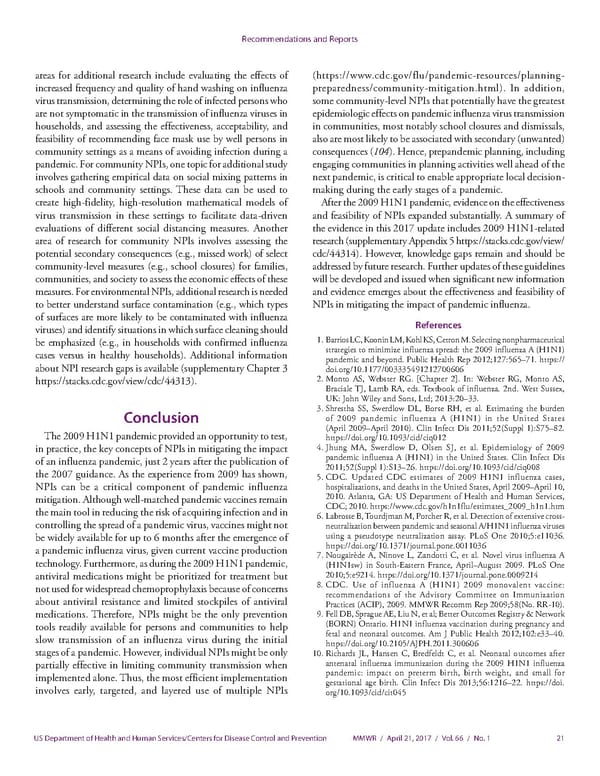Recommendations and Reports areas for additional research include evaluating the effects of (https://www.cdc.gov/flu/pandemic-resources/planning- increased frequency and quality of hand washing on influenza preparedness/community-mitigation.html). In addition, virus transmission, determining the role of infected persons who some community-level NPIs that potentially have the greatest are not symptomatic in the transmission of influenza viruses in epidemiologic effects on pandemic influenza virus transmission households, and assessing the effectiveness, acceptability, and in communities, most notably school closures and dismissals, feasibility of recommending face mask use by well persons in also are most likely to be associated with secondary (unwanted) community settings as a means of avoiding infection during a consequences (104). Hence, prepandemic planning, including pandemic. For community NPIs, one topic for additional study engaging communities in planning activities well ahead of the involves gathering empirical data on social mixing patterns in next pandemic, is critical to enable appropriate local decision- schools and community settings. These data can be used to making during the early stages of a pandemic. create high-fidelity, high-resolution mathematical models of After the 2009 H1N1 pandemic, evidence on the effectiveness virus transmission in these settings to facilitate data-driven and feasibility of NPIs expanded substantially. A summary of evaluations of different social distancing measures. Another the evidence in this 2017 update includes 2009 H1N1-related area of research for community NPIs involves assessing the research (supplementary Appendix 5 https://stacks.cdc.gov/view/ potential secondary consequences (e.g., missed work) of select cdc/44314). However, knowledge gaps remain and should be community-level measures (e.g., school closures) for families, addressed by future research. Further updates of these guidelines communities, and society to assess the economic effects of these will be developed and issued when significant new information measures. For environmental NPIs, additional research is needed and evidence emerges about the effectiveness and feasibility of to better understand surface contamination (e.g., which types NPIs in mitigating the impact of pandemic influenza. of surfaces are more likely to be contaminated with influenza viruses) and identify situations in which surface cleaning should References be emphasized (e.g., in households with confirmed influenza 1. Barrios LC, Koonin LM, Kohl KS, Cetron M. Selecting nonpharmaceutical cases versus in healthy households). Additional information strategies to minimize influenza spread: the 2009 influenza A (H1N1) pandemic and beyond. Public Health Rep 2012;127:565–71. https:// about NPI research gaps is available (supplementary Chapter 3 doi.org/10.1177/003335491212700606 https://stacks.cdc.gov/view/cdc/44313). 2. Monto AS, Webster RG. [Chapter 2]. In: Webster RG, Monto AS, Braciale TJ, Lamb RA, eds. Textbook of influenza. 2nd. West Sussex, UK: John Wiley and Sons, Ltd; 2013:20–33. 3. Shrestha SS, Swerdlow DL, Borse RH, et al. Estimating the burden Conclusion of 2009 pandemic influenza A (H1N1) in the United States (April 2009–April 2010). Clin Infect Dis 2011;52(Suppl 1):S75–82. The 2009 H1N1 pandemic provided an opportunity to test, https://doi.org/10.1093/cid/ciq012 in practice, the key concepts of NPIs in mitigating the impact 4. Jhung MA, Swerdlow D, Olsen SJ, et al. Epidemiology of 2009 of an influenza pandemic, just 2 years after the publication of pandemic influenza A (H1N1) in the United States. Clin Infect Dis the 2007 guidance. As the experience from 2009 has shown, 2011;52(Suppl 1):S13–26. https://doi.org/10.1093/cid/ciq008 5. CDC. Updated CDC estimates of 2009 H1N1 influenza cases, NPIs can be a critical component of pandemic influenza hospitalizations, and deaths in the United States, April 2009–April 10, mitigation. Although well-matched pandemic vaccines remain 2010. Atlanta, GA: US Department of Health and Human Services, the main tool in reducing the risk of acquiring infection and in CDC; 2010. https://www.cdc.gov/h1n1flu/estimates_2009_h1n1.htm 6. Labrosse B, Tourdjman M, Porcher R, et al. Detection of extensive cross- controlling the spread of a pandemic virus, vaccines might not neutralization between pandemic and seasonal A/H1N1 influenza viruses be widely available for up to 6 months after the emergence of using a pseudotype neutralization assay. PLoS One 2010;5:e11036. a pandemic influenza virus, given current vaccine production https://doi.org/10.1371/journal.pone.0011036 7. Nougairède A, Ninove L, Zandotti C, et al. Novel virus influenza A technology. Furthermore, as during the 2009 H1N1 pandemic, (H1N1sw) in South-Eastern France, April–August 2009. PLoS One antiviral medications might be prioritized for treatment but 2010;5:e9214. https://doi.org/10.1371/journal.pone.0009214 not used for widespread chemoprophylaxis because of concerns 8. CDC. Use of influenza A (H1N1) 2009 monovalent vaccine: about antiviral resistance and limited stockpiles of antiviral recommendations of the Advisory Committee on Immunization Practices (ACIP), 2009. MMWR Recomm Rep 2009;58(No. RR-10). medications. Therefore, NPIs might be the only prevention 9. Fell DB, Sprague AE, Liu N, et al; Better Outcomes Registry & Network tools readily available for persons and communities to help (BORN) Ontario. H1N1 influenza vaccination during pregnancy and slow transmission of an influenza virus during the initial fetal and neonatal outcomes. Am J Public Health 2012;102:e33–40. https://doi.org/10.2105/AJPH.2011.300606 stages of a pandemic. However, individual NPIs might be only 10. Richards JL, Hansen C, Bredfeldt C, et al. Neonatal outcomes after partially effective in limiting community transmission when antenatal influenza immunization during the 2009 H1N1 influenza implemented alone. Thus, the most efficient implementation pandemic: impact on preterm birth, birth weight, and small for gestational age birth. Clin Infect Dis 2013;56:1216–22. https://doi. involves early, targeted, and layered use of multiple NPIs org/10.1093/cid/cit045 US Department of Health and Human Services/Centers for Disease Control and Prevention MMWR / April 21, 2017 / Vol. 66 / No. 1 21
 Community Mitigation Guidelines to Prevent Pandemic Influenza Page 22 Page 24
Community Mitigation Guidelines to Prevent Pandemic Influenza Page 22 Page 24